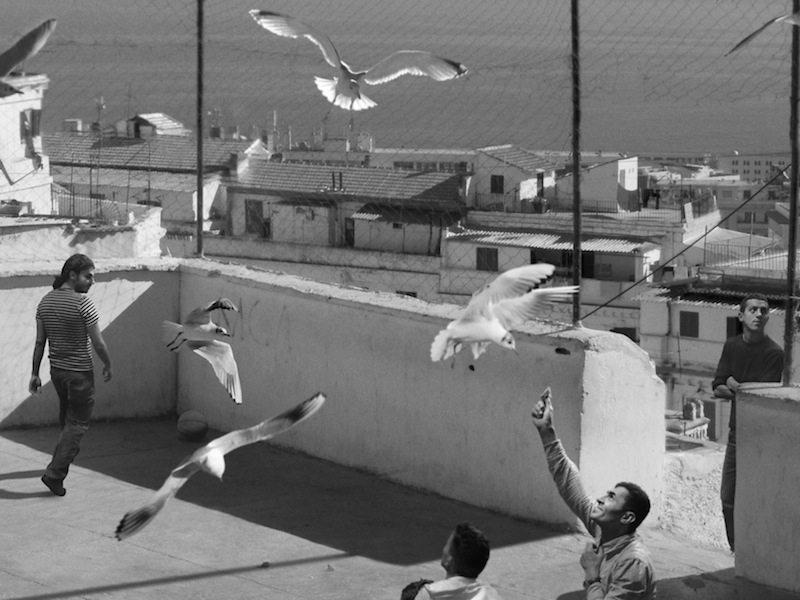‘“Time is out of joint”: it is off the hinges assigned to it by behaviour in the world, but also by movements of world.’ Gilles Deleuze’s quotation from Hamlet in Cinema 2: The Time-Image (1985) describes how, since modernity, time no longer functions as a measure for movement or actions, but rather begins to appear for and by itself. Similarly, the six videos on show here, spanning some 15 years of David Claerbout’s production, turn time tactile, almost sculptural; and while duration is not their subject matter, they render it phenomenologically perceptible. As in previous presentations, such as at the Centre Pompidou in Paris in 2007, the works are shown in proximity to each other, projected onto the walls and a translucent sheet of white fabric that spans the space diagonally.
Oil workers (from the Shell company of Nigeria) returning home from work, caught in torrential rain (2013) depicts a group of men seeking shelter under a bridge. Some are en route on motor-bikes, some on foot, with a large puddle of muddy water visible in the foreground of the almost painterly composition. The camera appears tenaciously to rotate around the men in three-dimensional space, while the picture itself remains still. At the end of the sequence, the focus turns to the subtly animated water, then reemerges and repeats the rotation in an elliptical movement. Claerbout constructed the image using 3D technology, after a JPEG file found on the Internet carrying the tagline that lends the work its title. The workers seem to be waiting – for the rain to pass, or for better days. Time passes slower when we wait, and waiting is economically unproductive and hence unpaid. The specific temporality of the piece and that of the ‘actual’ world surrounding it in the exhibition space are conflated as distinct durations that coexist within a single event.
In contrast to those waiting moments, time speeds up when we enjoy ourselves. In The Algiers’ Sections of a Happy Moment (2008), 600 projected photographs capture an instant of a recreational football game on the rooftop of a building in the casbah, when a man stops to feed a seagull. The still images are accompanied by light Arab guitar music and shown in a sequence unfolding the single moment over a period of time. The work both presents a moment in time, and concurrently represents time through the montage of shots that surpass the empirical timespan they depict. Conflating techniques of photography and cinematographic montage, Claerbout creates a hybrid between what Deleuze calls ‘time-image’, a direct presentation of time rather than its representation through movement, and ‘movement-image’, an image of time diverging from the ‘actual’ durational period of the depicted. With its multiple perspectives upon the same moment stretched in time, the work reminds us of the impossibility of subjective certainty and epistemological conclusions.
The translucent projection surface dividing the space at Marabouparken lets the six works seep through one another. The room is not darkened in black-box manner, and so allows the viewer’s time-space to entangle with that of the exhibition, reminiscent of what Henri Bergson describes as the real being reflected in the virtual. With time the denominator of the show, the confluence of disjointed visual content is partly diverting, yet also points to the simultaneity of realities, filmic and otherwise mediated. The exhibition demands time and patience. Considering today’s superfluous media-created imagery and accelerated time perception, paying (durational) attention to a single moment seems like a pertinent attitude.
Marabouparken, Stockholm 9 October – 14 February
This article first appeared in the January & February 2016 issue of ArtReview.
